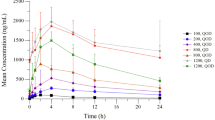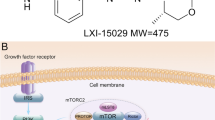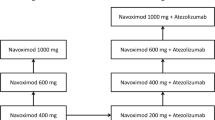Abstract
Purpose
This phase I study was conducted to evaluate the safety and Maximum Tolerated Dose of PENAO (4-(N-(S-penicillaminylacetyl)amino)-phenylarsonous acid), a second-generation organic arsenical with anti-mitochondrial activity, when given as a continuous intravenous infusion (CIVI), in patients with advanced solid tumours.
Methods
Eligibility criteria for this trial included age ≥ 18 years, advanced solid tumour, ECOG Performance Status ≤ 1 and adequate organ function. PENAO was administered by CIVI, with dose levels initially increased by infusion duration in a 21-day cycle at a fixed daily dose and then increased daily dose. Standard dose-limiting toxicity (DLT) definitions were used in a “3 + 3” design. Patients had regular monitoring of toxicity and efficacy. Pharmacokinetic assays of serum and urine As were performed.
Results
Twenty-six patients were treated across 8 dose levels. The only dose-limiting toxicity (DLT) observed was fatigue, that occurred in one patient treated at the highest dose level of 9 mg/m2/day. No significant organ toxicity or objective responses were observed, although there were two patients with stable disease lasting up to 7 months. Pharmacokinetic analysis unexpectedly indicated a half-life of 9–19 days, invalidating the CIVI dosing resulting in discontinuation of the study before the RP2D was defined.
Conclusions
PENAO was administered by CIVI at dose levels up to 9 mg/m2/day with only one DLT noted. Pharmacokinetic studies invalidated the rationale for continuous dosing and led to discontinuation of the trial without defining a RP2D. Future clinical development of PENAO will use intermittent dosing schedule, alone and in combination with rapamycin.

Similar content being viewed by others
References
Mathupala S, Ko Y, Pederson P (2010) The pivotal role of mitochondria in cancer: warburg and beyond and encouraging prospects for effective therapies. Biochim Biophys Acts 1797:1225–1230
Rempel a, Bannasch P, Mayer D, (1994) Differences in expression and intracellular distribution of hexokinase isoenzymes in rat liver cells of different transformation stages. Biochim Biophys Acta 1219:660–668
Halestrap A (2009) What is the mitochondrial permeability transition pore? J Mol Cell Cardiol 46:821–831
Horsley L, Cummings J, Middleton M, Ward T, Backen A, Clamp A, Dawson M, Farmer H, Fisher N, Halbert G, Halford S, Harris A, Hasan J, Hogg P, Kumaran G, Little R, Parker G, Potter P, Saunders M, Roberts C, Shaw D, Smith N, Smythe J, Taylor A, Turner H, Watson Y, Dive C, Jayson G (2013) A phase 1 trial of GSAO in patients with advanced solid tumours. Cancer Chemother Pharmacol 72:1343–1352
Dilda P, Decollogne S, Weerakoon L, Norris M, Haber M, Allen J, Hogg P (2009) Optimization of the antitumor efficacy of a synthetic mitochondrial toxin by increasing the residence time in the cytosol. J Med Chem 52:6209–6216
Pepin J, Milford F (1994) The treatment of African trypanosomiasis. Adv Parasitol 33:1–47
Soignet S, Tong W, Hirschfeld S, Warrell R Jr (1999) Clinical study of an organic arensical, melarsoprol, in patients with advanced leukaemia. Cancer Chemother Pharmacol 44:417–421
Rousellot P, Larghero J, Arnulf B, Poupon J, Royer B, Tibi A, Madelaine-Chambrin I, Cimerman P, Chevret S, Hermine O, Dombret H, Claude Brouet J, Paul Fernand J (2004) A clinical and pharmacological study of arsenic trioxide in advanced multiple myeloma patients. Leukaemia 18:1518–1521
Tsimberidou A, Kantarjian H, Garcia-Manero G, Koller C, Jones D, Keating M, Estey E (2006) Clincal outcomes and rates of molecular remission with alltrans retinoic acid (ATRA) and arsenic trioxide (As2O3) combination therapy in newly diagnosed acute promyelocytic leukaemia (APL) In: Oncology. JoC ed: 2006 ASCO Annual Meeting Proceedings
Tsimberidou A, Camacho L, Verstovsek S, Ng C, Hong D, Uehara C, Gutierrez C, Daring S, Stevens J, Komarnitsky P, Schwartz B, Kurzrock R (2009) A phase I clinical trial of darinaparsin in patients with refractory solid tumours. Clin Cancer Res 15(14):4769–4776
Brindley C (2010) The pharmacokinetics of PENAO were predicted in humans by allometric scaling from plasma concentrations of PENAO after intravenous bolus administration to rats. A biexponential function was selected to represent the plasma concentrations of PENAO and used to predict pharmacokinetic parameters in man by an empirical allometric approach. The predicted pharmacokinetic parameters were used to simulate plasma concentration of PENAO following a 24 hour infusion in man. Predicted human t1/2 was 2.88 h. (Unpublished raw data)
Hogg P (2021) Toxicokinetics of the tumour cell mitochondrial toxin, PENAO, in rodents. Investigational New Drugs
Polekhina OV, Obraztsov NV, Petrunin VA, Vysotskaya TA (2014) Interspecies pharmacokinetics 1. Allometric scaling of pharmacokinetic parameters (a review). Pharm Chem J 48:421–429
Kang HE, Lee MG (2011) Approaches for predicting human pharmacokinetics using interspecies pharmacokinetic scaling. Arch Pharm Res 34(11):1779–1788
Hu J, Fang J, Dong Y, Chen SJ, Chen Z (2005) Arsenic in cancer therapy. Anticancer Drugs 16(2):119–127
Swindell E, Hankins P, Chen H, Miodragovic D, O’Halloran T (2013) Anticancer activity of small-molecule and nanoparticulate arsenic(III) complexes. Inorg Chem 52:12292–12304
Sumeda NC, Miltonprabu S (2015) Diallyl trisulfide ameliorates arsenic-induced hepatotoxicity by abrogation of oxidative stress, inflammation and apoptosis in rats. Hum Exp Toxicol 34(5):506–525
Mochizuki H (2019) Arsenic neurotoxicity in humans. Int J Mol Sci 1(14):3418
Alamolhodaei NS, Shirani K, Karimi G (2015) Arsenic cardiotoxicity: an overview. Environ Toxicol Pharmacol 40:1005–1014
Dilda P, Hogg P (2007) Arsenical-based cancer drugs. Cancer Treat Rev 33:542–564
Wu S, Chen J, Kudelka A, Lu J, Zhu X (2008) Incidence and risk of hypertension with sorafenib in patients with cancer: a systematic review and meta-analysis. Lancet Oncol 9(2):117–123
Zhu X, Stergiopoulos K, Wu S (2009) Risk of hypertension and renal dysfunction with angiogenesis inhibitor sunitinib: systematic review and meta-analysis. Acta Oncol 48(1):9–17
An MM, Zou Z, Shen H, Liu P, Chen ML, Cao YB, Jiang YY (2010) Incidence and risk of significantly raised blood pressure in cancer patients treated with bevacizumab: an updated meta-analysis. Eur J Clin Pharmacol 66:813–821
Decollogne S, Joshi S, Chung S, Luk P, Xeo R, Nixdrof S, Fedier A, Heinzelmann-Schwarz V, Hogg P, Dilda P (2015) Alterations in the mitochondrial responses to PENAO as a mechanism of resistance in ovarian cancer cells. Gynecol Oncol 138(2):363–371
Tsoli M, Liu J, Franshaw L, Shen H, Cheng C, Jung MS, Joshi S, Ehteda A, Khan A, Montero-Carcabosso A, Dilda P, Hogg P, Ziegler D (2018) Dual targeting of mitochondrial function and mTOR pathway as a therapeutic strategy for diffuse intrinsic pontine glioma. Oncotarget 9:7541–7556
Author information
Authors and Affiliations
Corresponding author
Ethics declarations
Conflict of interest
Ben Tran has received financial support from Amgen and Astellas Pharma. Ben Tran has received honoraria from Astellas Pharma, Janssen-Cilag, Sanofi, Tolmar and Amgen. Ben Tran has received institutional research funding from Astellas Pharma, Janssen-Cilag, Amgen, Pfizer, Genentech, AstraZeneca, Bayer, Bristol-Myers Squibb, Merck Sharp and Dohme and Ispen. Danny Rischin received grants from Merck, Bristol-Myers Squibb, Roche and Regeneron. Danny Rischin has also received grants and personal fees from GlaxoSmithKline and Merck Sharp and Dohme. Ben Tran has acted in an advisory or consultant role for Amgen, Astellas Pharma, Bayer, Sanofi, Tolmar, Janssen-Cilag, Bristol-Myers Squibb, Ipsen, Merck Sharp and Dohme and AstraZeneca. Peter Savvas has acted as an uncompensated Consultant for Roche-Genentech. Danny Rischin has had uncompensated role on Trial Steering Committees and/or advisory boards for Merck Sharp and Dohme, Bristol-Myers Squibb, GlaxoSmithKline, Regeneron and Sanofi.
Additional information
Publisher's Note
Springer Nature remains neutral with regard to jurisdictional claims in published maps and institutional affiliations.
Rights and permissions
About this article
Cite this article
Sarkar, S., Tran, B., Horvath, L. et al. A phase 1 trial of 4-(N-(S-penicillaminylacetyl)amino)-phenylarsonous acid (PENAO) in patients with advanced solid tumours. Cancer Chemother Pharmacol 87, 613–620 (2021). https://doi.org/10.1007/s00280-020-04225-7
Received:
Accepted:
Published:
Issue Date:
DOI: https://doi.org/10.1007/s00280-020-04225-7




